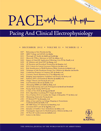Fluoroscopic and Electrical Assessment of a Series of Defibrillation Leads: Prevalence of Externalized Conductors
Kodoth, Ashfield Cromie: No disclosures to declare.
E. Hodkinson: Sponsorship from SJM, Pfizer, Attendance at Medtronic and Boston Scientific training courses.
R.L. Noad: Honorarium from Medtronic, Servier, Astra Zeneca Pharmaceuticals, Abbott Laboratories, Boehringer Ingelheim.
D.J. McEneaney: Honorarium from St. Jude Medical/Medtronic/Biotronik.
C.M. Wilson: Honorarium from Medtronic, Boston Scientific Corp., Pfizer, Inc., St. Jude Medical, Boehringer Ingelheim, Servier.
M.J. Roberts: Honorarium from St. Jude Medical, Medtronic, Sanofi Aventis, Boston Scientific Corp., Personalis.
Abstract
Introduction : Insulation defects with externalized conductors have been reported in the St. Jude Riata® family of defibrillation leads (St. Jude Medical, Sylmar, CA, USA). The objective of the Northern Ireland Riata® lead screening program was to identify insulation defects and externalized conductors by systematic fluoroscopic and electrical assessment in a prospectively defined cohort of patients. We sought to estimate the prevalence, identify risk factors, and determine the natural history of this abnormality.
Methods : All patients with a Riata® lead under follow-up at the Royal Victoria Hospital were invited for fluoroscopic imaging and implantable cardioverter-defibrillator lead parameter checks. Fluoroscopic images were read independently by two cardiologists and the presence of externalized conductors was classified as positive, negative, or borderline.
Results: One hundred and sixty-five of 212 patients with a Riata lead were evaluated by fluoroscopy and lead parameter measurements. The mean duration after implantation was 3.98+/−1.43 years. After screening 25 (15%) patients were classified as positive, 137 (83%) negative, and three (1.8%) borderline. Time since implantation (P = 0.001), presence of a single coil lead (P = 0.042), and patient age (P = 0.034) were significantly associated with externalized conductors. The observed rate of externalized conductors was 26.9% for 8-French and 4.7% for 7-French leads. No leads that were identified prospectively with externalized conductors had electrical abnormalities. Seven of 25 (28%) patients had a defective lead extracted by the end of this screening period.
Conclusion: A significant proportion (15%) of patients with a Riata lead had an insulation breach 4 years after implantation. High-resolution fluoroscopic imaging in at least two orthogonal views is required to identify this abnormality. (PACE 2012;35:1498–1504)




